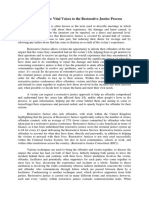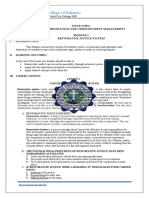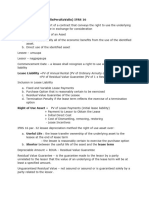FINAL ASSIGNMENT 2.
FINAL ASSIGNMENT 2.
Uploaded by
Dun Blane TabaresCopyright:
Available Formats
FINAL ASSIGNMENT 2.
FINAL ASSIGNMENT 2.
Uploaded by
Dun Blane TabaresCopyright
Available Formats
Share this document
Did you find this document useful?
Is this content inappropriate?
Copyright:
Available Formats
FINAL ASSIGNMENT 2.
FINAL ASSIGNMENT 2.
Uploaded by
Dun Blane TabaresCopyright:
Available Formats
DUN BLANE L.
TABARES
MSC 109
FINAL ASSIGNMENT 2
Community Corrections is really important in the society that we live in
today. It has helped a lot of people not just the victims but also the offenders
to be able to regain their lives and be reintegrated to the society. It is a way
for offenders to contemplate on the things they have done and be treated in
a way that they will be accepted again in the society as a new individual.
Community corrections programs attempt to accomplish many goals.
These goals include easing institutional crowding and cost; preventing
future criminal behaviour through surveillance, rehabilitation, and
community reintegration; and addressing victims’ needs through restorative
justice.
Community Correction is the management of offenders in the
community who have already been convicted. Community corrections are an
alternative to imprisonment. Offenders report regularly to their community
officers and may be forced to participate in unpaid community work and
rehabilitation programs. The community corrections include probation, parole
and pre-trial supervision. Probation entails the release of an offender to the
community under supervision, parole is the conditional supervised release
from jail and pre-trial supervision is the close monitoring of an individual
before trial.
Community corrections is more accurately called community- based
correctional services .These community based programs are intended to
continue an offender’s punishment, but in the contest of the community
rather than in a correctional centre. Another term that is often used
synonymously with community corrections is intermediate punishments.
Community corrections sentences and models are designed to consider
both the safety of the local residents as well as the treatment needs of
offenders. Community corrections sentences recognize that some crimes
do not require intervention which calls for imprisonment. Sanctions
developed within the community are alternatives to sentences that remove
the offender from his or her family job and neighbourhood. The underlying
theme of community corrections is that justice is an active process. The
offender must participate in this process. Supporters of community
corrections recognize that many offenders can still be valuable and
contributing members of society despite having a criminal record
(conviction). The way corrections programmes are developed and operated
cannot be understood outside the contest of a variety of socio-political in
influences. Trends, in governments, economics, history and social
movements all affect the policies that are formulated and implemented.
Legislatures, various structures of leadership, civilians, politicians,
researchers and criminal justice practitioners may all have different views
on what is necessary to make community corrections affective. Yet for any
programme to be successful they all must work together. To assess the
quality efficiency and effectiveness of present community corrections
systems, we must first decide what it is we believe such a system should
accomplish. Our ideas and expectations about the goals of punishment are
the cornerstone of our investigation into the value of our current system by
critically analysing the operation and results of contemporary community
corrections; we can visualize ways to improve the system.
Restorative justice assumes that a crime harms the community and
that sometimes there are individual victims involved. Often, victims of
property crimes just want to be paid back or have things restored to their
former condition— something that may not be possible if the offender goes
to jail or prison. Restorative justice emphasizes offender responsibility to
repair the injustice that offenders have caused their victims. Through victim
and community involvement, such as face-to-face mediation sessions,
victim impact panels, and volunteer mentoring, the offender remains in the
community, completes community service, and pays victim restitution.
Restorative justice is most effective for property crimes, particularly those
committed by juveniles or first-time adult felony offenders.
Re-integration: The term refers to the process of re-inclusion of the
discharged released offenders into the community and the change in his or
her inclinations and behaviour. The community and how effectively
rehabilitation is supported by the community in the re-integration process.
Any form of correctional treatment must be linked to the offender’s
integration. Offenders must be prepared for new roles and accepted
participation in community life is central to reintegration. The following are
important characteristics of reintegration: Close liaison between the
correctional centre or community corrections office and the community is
encouraged. Social reform in correctional centres through bridging the gap
between in institutional and community life is emphasized. The offender is
involved in the decision – making process. Behavioural changes of the
offender are noted, Correctional officials are involved in the rehabilitation
process. The community should be involved and should participate in
offender’s re-integration.
Community corrections also breaks the cycle of reoffending by
developing the offenders capabilities and treating those with problems
such as personality disorders. The community corrections are an
effective way to reduce crime. This is majorly through learning a close
supervision of the offender. The close supervision ensures that the
offender abides to the rules and regulations stipulated. The offender
tries as much as possible to follow the set conditions in order to avoid
jail.
You might also like
- Oliver TwistDocument28 pagesOliver TwistTarik Aatta67% (3)
- Swot AnalysisDocument36 pagesSwot AnalysisMaria January Vii87% (15)
- Restorative Justice PresentationDocument30 pagesRestorative Justice PresentationRabhak Khal-Hadjj100% (4)
- Bitumen Rates 01.04.2018Document1 pageBitumen Rates 01.04.2018karunamoorthi_p220925% (4)
- Community Service As A Form of Non Institutional Correction Assessing Its Impact On Offender RehabilitationDocument8 pagesCommunity Service As A Form of Non Institutional Correction Assessing Its Impact On Offender RehabilitationDORMIENDO AIRAH JANE TUTORNo ratings yet
- CA 2 Notes RevisedDocument306 pagesCA 2 Notes RevisedLovely-Lou LaurenaNo ratings yet
- Community-Based Treatment For Offenders in The Philippines: Old Concepts, New Approaches, Best PracticesDocument28 pagesCommunity-Based Treatment For Offenders in The Philippines: Old Concepts, New Approaches, Best PracticesPringkles81No ratings yet
- ReferenceDocument14 pagesReferencePj TignimanNo ratings yet
- Community Justice Whats in It For YouDocument7 pagesCommunity Justice Whats in It For YounayabNo ratings yet
- Babby Boo PDFDocument4 pagesBabby Boo PDFUnathi LionNo ratings yet
- Sentences and SentencingDocument26 pagesSentences and SentencingADVOCATE SANJEEV KUMARNo ratings yet
- Restorative JusticeDocument3 pagesRestorative JusticeApeksha TiwariNo ratings yet
- Community ServiceDocument5 pagesCommunity ServiceMădălina GlijinNo ratings yet
- Non-Institutional CorrectionDocument35 pagesNon-Institutional CorrectionCamille QuiñoneroNo ratings yet
- Punitive and Reformative Treatment of CriminalsDocument18 pagesPunitive and Reformative Treatment of Criminalsazka batoolNo ratings yet
- Restorative Justice MaterialDocument4 pagesRestorative Justice MaterialKarman BhullarNo ratings yet
- Role of The Community in Corrections: Improving Offender-Family Relations To Improve TreatmentDocument11 pagesRole of The Community in Corrections: Improving Offender-Family Relations To Improve Treatmentmart09211991100% (2)
- Restorative JusticeDocument34 pagesRestorative JusticeEmelita Girlie Cruz-BolivarNo ratings yet
- Estorative Justice: Amends EncounterDocument8 pagesEstorative Justice: Amends EncounterRico T. MusongNo ratings yet
- Non - Institutional Corrections - CADocument7 pagesNon - Institutional Corrections - CArudelyntingcang2023No ratings yet
- Check Your Price: Importance of The Corrections Within The Criminal Justice System Essay Topic:LawDocument5 pagesCheck Your Price: Importance of The Corrections Within The Criminal Justice System Essay Topic:LawjonardNo ratings yet
- Argumentation and DebateDocument10 pagesArgumentation and Debatetrorse7No ratings yet
- Module 1 of CA2: Non-Institutional CorrectionDocument8 pagesModule 1 of CA2: Non-Institutional CorrectionMut4nt TVNo ratings yet
- Ca2 Reviewer 1Document69 pagesCa2 Reviewer 1Jasmin KayessNo ratings yet
- Non Institutional Correction-1Document6 pagesNon Institutional Correction-1Skier Mish33% (3)
- Module in Non Institutional CorrectionsDocument97 pagesModule in Non Institutional CorrectionsDante Bacud Formoso IIINo ratings yet
- InterventionDocument18 pagesInterventionmharieNo ratings yet
- Group 5 Report 1Document27 pagesGroup 5 Report 1Sanny BaronNo ratings yet
- Chapter 1Document6 pagesChapter 1Sherwin RonquilloNo ratings yet
- Community-Based Correction and Its BackgroundDocument6 pagesCommunity-Based Correction and Its Background2208 ABANILLA MARK KHEVINNo ratings yet
- Module in CA 321Document79 pagesModule in CA 321Jayvee AbaloyanNo ratings yet
- CA302Document15 pagesCA302jun mark cardinas romeralNo ratings yet
- Community CorrectionDocument11 pagesCommunity CorrectionLeetetja Sylvia Ngoasheng MakgakgaNo ratings yet
- Corrections and Community JusticeDocument38 pagesCorrections and Community JusticejjjjNo ratings yet
- Социальная Реинтеграция Осужденныхх АнглDocument15 pagesСоциальная Реинтеграция Осужденныхх АнглIrina KonstantinovaNo ratings yet
- Community CorrectionDocument7 pagesCommunity Correctionricha ayengiaNo ratings yet
- Comparison To Our Law Now With RJDocument6 pagesComparison To Our Law Now With RJZydalgLadyz NeadNo ratings yet
- Non Institutional Correction 1Document6 pagesNon Institutional Correction 1Robert Podiotan MantosNo ratings yet
- Reflection Paper CA2Document3 pagesReflection Paper CA2Roanne May SumayloNo ratings yet
- Overview of The Community Correction System of The PhilippinesDocument9 pagesOverview of The Community Correction System of The PhilippinesT'chon SkylerNo ratings yet
- First WeekDocument3 pagesFirst WeekJonalyn NicdaoNo ratings yet
- Identify Six RehabilititiveDocument15 pagesIdentify Six Rehabilititivejames waweruNo ratings yet
- Capstone PaperDocument12 pagesCapstone Paperndikumanafrancois411No ratings yet
- Treatment of CriminalsDocument7 pagesTreatment of CriminalsMuhammad HasnainNo ratings yet
- (Tesis) - Social ReintegrationDocument36 pages(Tesis) - Social ReintegrationPriss SaezNo ratings yet
- Community Members: Vital Voices To The Restorative Justice ProcessDocument5 pagesCommunity Members: Vital Voices To The Restorative Justice ProcessMel JuarezNo ratings yet
- What Is Restorative Justice?: Community SafetyDocument5 pagesWhat Is Restorative Justice?: Community SafetyDe Guzman E AldrinNo ratings yet
- Module in Crim 15 Lesson 2Document4 pagesModule in Crim 15 Lesson 2Geneva DulaganNo ratings yet
- Major Progs Under EO 43Document3 pagesMajor Progs Under EO 43ppadojNo ratings yet
- UntitledDocument5 pagesUntitledHillarthy PerniciousNo ratings yet
- RJ Critical Analysis 4Document4 pagesRJ Critical Analysis 4api-706268506No ratings yet
- Rehabilitation PaperDocument7 pagesRehabilitation PaperGino1775No ratings yet
- Chapter 9. Community PolicingDocument10 pagesChapter 9. Community PolicinglosangelesNo ratings yet
- Dispute ResolutionDocument17 pagesDispute Resolutionabbyabejuela19No ratings yet
- Ca 2 Week 1Document3 pagesCa 2 Week 1mirameee131No ratings yet
- Criminal Rehabilitation and Therapeutic Community ModalityDocument28 pagesCriminal Rehabilitation and Therapeutic Community Modalityzaynagustin4No ratings yet
- Therapeutic Module Final2xDocument55 pagesTherapeutic Module Final2xPrincess Lee GuialiNo ratings yet
- Postion PaperDocument4 pagesPostion PaperFernandez, Royce Red L.No ratings yet
- The International Handbook of Gender and Poverty Concepts, Research, PolicyDocument733 pagesThe International Handbook of Gender and Poverty Concepts, Research, PolicyArsalan Raza100% (4)
- The Development of International Investment Law (2/2)Document3 pagesThe Development of International Investment Law (2/2)ManuelNo ratings yet
- Ashanti v. Hulick - Document No. 4Document2 pagesAshanti v. Hulick - Document No. 4Justia.comNo ratings yet
- Verbal Reasoniing For CATDocument10 pagesVerbal Reasoniing For CATjs kalyana ramaNo ratings yet
- Air Power History 2017 FallDocument68 pagesAir Power History 2017 FallPaul CultreraNo ratings yet
- Separation of Powers: Universiti Kebangsaan Malaysia Faculty of LawDocument32 pagesSeparation of Powers: Universiti Kebangsaan Malaysia Faculty of LawMusbri MohamedNo ratings yet
- Bengal TigerDocument1 pageBengal Tigeramitwatts86No ratings yet
- Circular 2013-06Document3 pagesCircular 2013-06Minnie AgdeppaNo ratings yet
- PovertyDocument4 pagesPovertyprahalladadas20No ratings yet
- Universal JurisdictionDocument20 pagesUniversal JurisdictionAhgilah Mitra100% (1)
- Certification: Department of EducationDocument9 pagesCertification: Department of EducationJustin bejie bautistaNo ratings yet
- Inglese Eta Vittoriana VerificaDocument2 pagesInglese Eta Vittoriana Verificaale labo 05No ratings yet
- Writing Great Copy: Where Do You Start?: 1. Headline. Many Copywriters Start With The Headline. They Write Many DifferentDocument5 pagesWriting Great Copy: Where Do You Start?: 1. Headline. Many Copywriters Start With The Headline. They Write Many DifferentFIngerstyle GuitasNo ratings yet
- Ortega vs. CADocument2 pagesOrtega vs. CAKristine Hipolito SerranoNo ratings yet
- Vitrified Clay Pipe and PVCDocument4 pagesVitrified Clay Pipe and PVCYan YanNo ratings yet
- Tender No.10-Empanelment of Vendors For Printing & Supply of Dairy 2019Document18 pagesTender No.10-Empanelment of Vendors For Printing & Supply of Dairy 2019ravi196No ratings yet
- Lease AccountingDocument2 pagesLease Accountingbuenaflorgladys11No ratings yet
- The Dancers by Alberto Florentino PDFDocument10 pagesThe Dancers by Alberto Florentino PDFJon Philip GarciaNo ratings yet
- New York Post - Vol. 220 No. 204 (07 Jun 2021)Document52 pagesNew York Post - Vol. 220 No. 204 (07 Jun 2021)Gavril BogdanNo ratings yet
- 2023 Joint BSP and GSP Backyard Camping Memo Punta EsDocument4 pages2023 Joint BSP and GSP Backyard Camping Memo Punta EsJAIZEL PILLAS100% (2)
- خطابات الضمان البنكيةDocument18 pagesخطابات الضمان البنكيةashtaa2009No ratings yet
- Functional LiteracyDocument3 pagesFunctional Literacysk rejaul100% (1)
- Fiverr HBA CourseDocument11 pagesFiverr HBA Coursesyedumarahmed52No ratings yet
- Wilhelm Dilthey The Essence of PhilosophyDocument79 pagesWilhelm Dilthey The Essence of Philosophyjagadeeshsreeram2100% (1)
- Workshop 1 - Ros Cuddihy North Wales PoliceDocument17 pagesWorkshop 1 - Ros Cuddihy North Wales PoliceBarnardosCymruNo ratings yet
- Nirf 2023 B. SC Physics SFDocument9 pagesNirf 2023 B. SC Physics SF20SUPH25 LAKSHMI SUDHAA RNo ratings yet
- Resume of Abdullah Farial SIrazDocument3 pagesResume of Abdullah Farial SIrazabdullah farialNo ratings yet
- D NG Bài Agree DisagreeDocument3 pagesD NG Bài Agree Disagreetridt0578No ratings yet

























































































